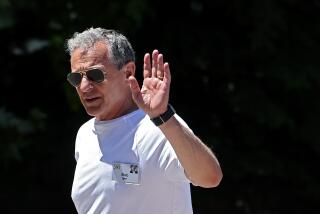Johnson Resigns Posts at GM to Return to Law Firm
- Share via
One of the few outsiders to reach a high-ranking post at General Motors and be considered a contender for the chairman’s job has resigned from the No. 1 auto maker to return to private law practice.
Elmer W. Johnson, who left the Chicago law firm of Kirkland & Ellis five years ago to become GM’s general counsel, was elected an executive vice president and director May 22, 1987.
Like another well-known outsider at GM, Texas billionaire H. Ross Perot, Johnson came to be known as a frustrated critic of GM, wanting it to change and shrink faster. But Johnson was neither as loud nor as public a critic as Perot.
In late 1986, Johnson engineered GM’s highly publicized $750-million buyout of Perot, who at the time was GM’s largest individual shareholder and a director. Perot founded Electronic Data Systems Corp., which he sold to GM.
William Hoglund, vice president in charge of GM’s Buick-Oldsmobile-Cadillac Group, is considered most likely to replace Johnson, who was in charge of GM’s legal, public affairs and operating staffs.
But GM spokesman Bill Winters said no decision had been made and he did not know when any executive changes would be made. The next scheduled board meeting is Aug. 1 in Detroit.
“Elmer Johnson has made significant and lasting contributions to General Motors over the past five years,” GM Chairman Roger Smith said in a statement after Johnson resigned Monday at a board meeting in New York.
“We will all miss our daily association with him and his abilities,” Smith said.
In the same statement, Johnson said: “My decision to retire from General Motors was based on a number of considerations,” but he did not list any.
“Over the last five years GM has undergone a number of extraordinary transactions. I’m glad that I had an opportunity to contribute to the process,” he said. Johnson said he is returning to his Chicago law firm.
Johnson, 56, resigned from the board and retired from his other GM post, but he won’t receive retirement benefits until he reaches age 65, and then will receive only an annuity based on his contribution to GM’s salaried retirement plan and any interest, Winters said.
Johnson hadn’t been with GM long enough to be eligible for the full range of GM retiree benefits, Winters said.
As recently as a year ago, Smith indicated that Johnson was among those who might succeed him as chairman when he retires in 1990. Other contenders included GM President Robert Stempel, Executive Vice President F. Alan Smith and Executive Vice President Lloyd E. Reuss.
“To begin with, usually everybody at GM has been there since right out of college. It’s like a lifetime career,” said Kathleen Heaney, analyst with Nikko Securities Co. International Inc. in New York.
In addition, Johnson was “a little bit critical, said the company wasn’t moving fast enough. For him to have gotten Roger Smith’s job in 1990 would have been a real long shot,” Heaney said.
GM also may be leaning toward promoting an executive with strong car-making experience, like Stempel, to quell criticism that the traditionally financial orientation of the company’s chairmen has hurt GM’s ability to bring competitive products to market, Heaney said.






